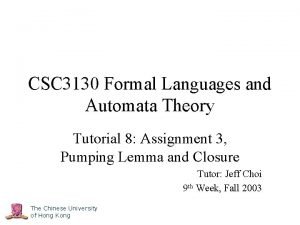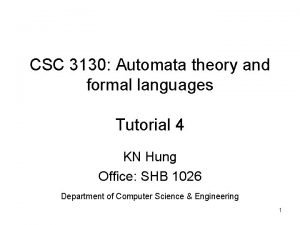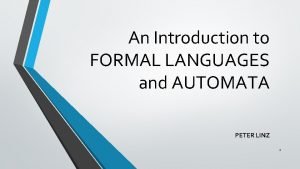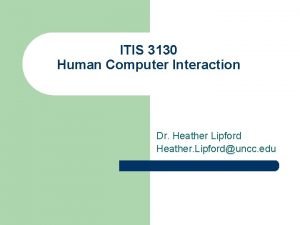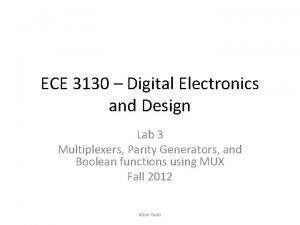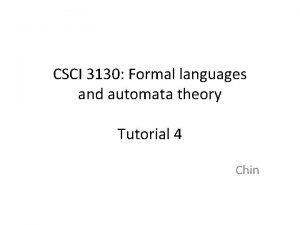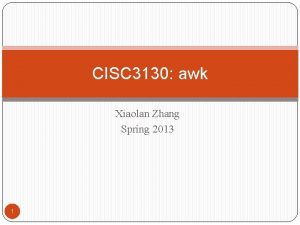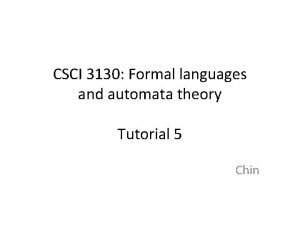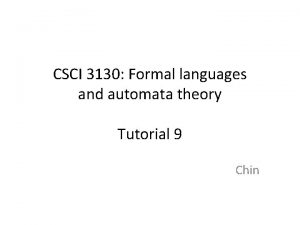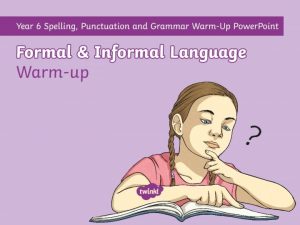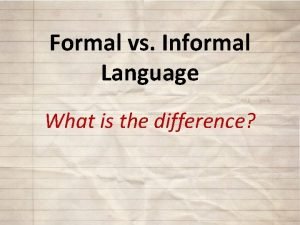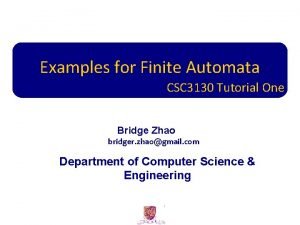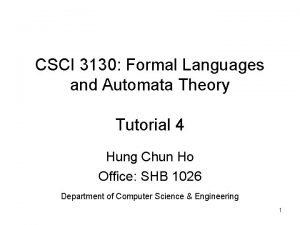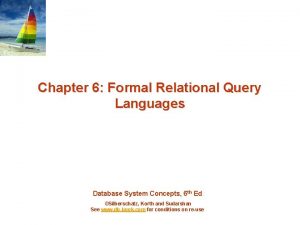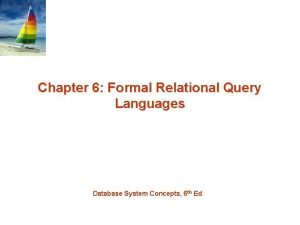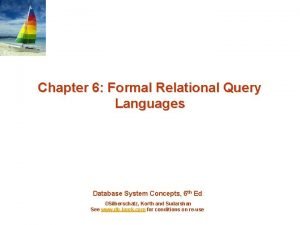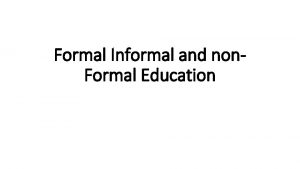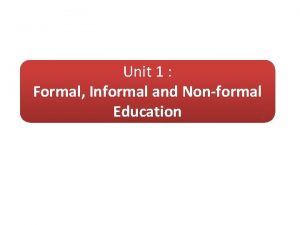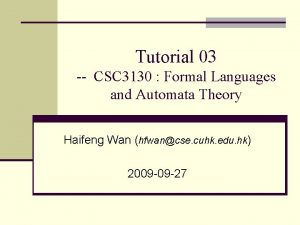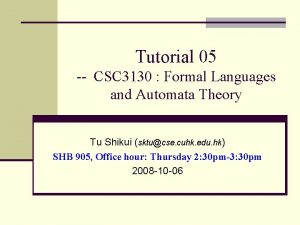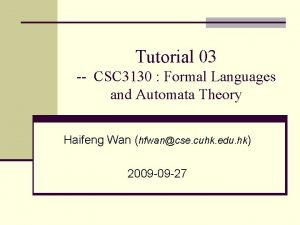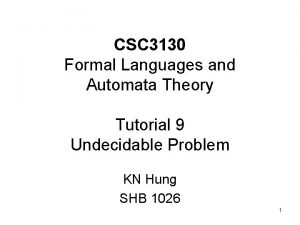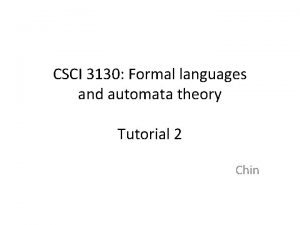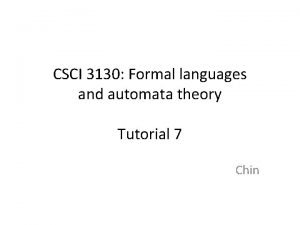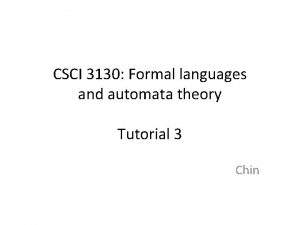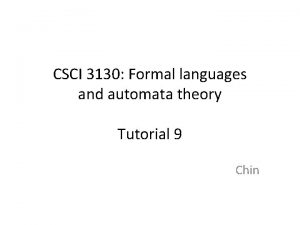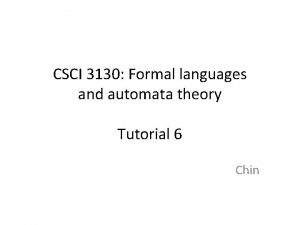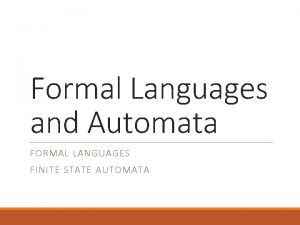Tutorial 02 CSC 3130 Formal Languages and Automata
























- Slides: 24

Tutorial 02 -- CSC 3130 : Formal Languages and Automata Theory Tu Shikui (sktu@cse. cuhk. edu. hk) SHB 905, Office hour: Thursday 2: 30 pm-3: 30 pm 2008 -09 -12

Outline n From NFA to NFA n From DFA to RE n Closed operators for Regular Languages

From NFA to NFA n -transitions n n is the empty string, “it contains no alphabets”; It makes a state transition when seeing . It makes a state transition without receiving an input symbol (from alphabet); It makes a state transition unconditionally; n NFA n n n NFA + Allows -transitions; It brings “programming convenience”; Closely related to regular expressions

From NFA to NFA -- an example from Lecture notes (1/8) NFA: , b a q 0 a a, b a q 1 a, b a q 2 a a q 2

From NFA to NFA -- an example from Lecture notes (2/8) NFA: q 0 , b a q 1 a q 2 (1) States stay the same (2) Start NFA: q 0 state q 1 stays the same q 2

From NFA to NFA -- an example from Lecture notes (3/8) q 0 NFA: Path in NFA: , b a … qi qi Equivalent Path in NFA: q 1 qk a a qj a qm q 2 … qj ? NFA: q 0 ? q 1 ? q 2

From NFA to NFA -- an example from Lecture notes (4/8) q 0 NFA: Path in NFA: , b a q 0 q 1 a q 0 Equivalent Path in NFA: a q 2 q 0 a NFA: q 0 ? q 1 ? q 2

From NFA to NFA -- an example from Lecture notes (5/8) q 0 NFA: Path in NFA: , b a q 0 Equivalent Path in NFA: q 0 a q 1 q 0 q 1 a a a, b q 1 ? a q 2 q 1 q 0 b q 1 q 2

From NFA to NFA -- an example from Lecture notes (6/8) q 0 NFA: Path in NFA: , b a q 0 Equivalent Path in NFA: q 0 a q 1 q 2 q 0 a, b a q 2 q 1 a, b a q 2 q 0 b q 1 q 2 b q 0 q 2

From NFA to NFA -- an example from Lecture notes (7/8) NFA: , b a q 0 a a, b a q 1 a, b a q 2 a a q 2

From NFA to NFA -- an example from Lecture notes (8/8) NFA: , b a q 0 q 1 a q 2 (4) The accepting states of the NFA are all states that can reach some accepting state of NFA using only -transitions NFA: q 0 a a, b a q 1 a, b a a q 2

Outline n From NFA to NFA n From DFA to RE n Closed operators for Regular Languages

From DFA to RE -- General construction n We inductively define Rijk as: Rii 0 = ai 1 + ai 2 + … + ait + e (all loops around qi and ) Rij 0 = ai + … + ai 1 2 t if i ≠ j (all qi → qj) qi qi ai 1, ai 2, …, ait qj Rijk = Rijk-1 + Rikk-1(Rkkk-1)*Rkjk-1 (for k > 0) qk qi a path in M qj

From DFA to RE -- an example (1/3) 1 q 1 1 0 q 2 0 R 110 = { , 1} = 1 + q 1 1 R 120 = {0} = 0 q 1 0 q 2 R 210 = {0} = 0 q 1 0 q 2 R 220 = { , 1} = 1 + 1 q 2

From DFA to RE Rijk = Rijk-1 + Rikk-1(Rkkk-1)*Rkjk-1 -- an example (2/3) 1 q 1 1 0 0 q 2 R 110 = { , 1} = 1 + ; R 210 = {0} = 0; R 111 = { , 1, 111, . . . } R 120 = {0} = 0 = 1* R 220 = { , 1} = 1 + 1 = R 0 + R 0(R 0)*R 0 1 0 0 R R 12 = R 12 + R 11 (R 11 )*R 12 22 22 21 11 12 = (1 + ) + 0(1+ )*0 = 0 + (1+ )+0 R 122 = R 121 + R 121(R 221)*R 221 = (0 + (1+ )+0) + (0 + (1+ )+0) ((1 + ) + 0(1+ )*0)+ = (0 + (1+ )+0) ((1 + ) + 0(1+ )*0)* = (1+ )*0 ((1 + ) + 01*0)* = 1*0 (1 + 01*0)*

From DFA to RE (3/3) -- Determine the accepted RE for DFA n Suppose the DFA start state is q 1, and the accepting states are F = {qj 1 qj 2 … qjt} n Then the regular expression for this DFA is R 1 j n + …. . + R 1 j n 1 1 q 1 2 t 1 0 0 q 2 R 122=1*0 (1+01*0)*

Outline n From NFA to NFA n From DFA to RE n Closed operators for Regular Languages

Closed operators for Regular Languages -- An Exercise n Prove or disprove the regular languages are closed under the following operations: (1). min(L) = { w | w is in L, but no proper prefix of w is in L }; n (2). max(L) = { w | w is in L and for no x other than εis wx in L }; n (3). init(L) = { w | for some x, wx is in L } n Hint: Start with a DFA for L and perform a construction to get the desired language.

(1). min(L) = { w | w is in L, but no proper prefix of w is in L }; What is “proper prefix”? For example, suppose the alphabet is { 0, 1 }, then: (1) “ 011”, “ 01” are proper prefixes of “ 0110001”; (2) “ 0110001” is a prefix of “ 0110001”, but not a proper prefix; (3) “” (i. e. , ε) is not a proper prefix of “ 0110001”.

(1). min(L) = { w | w is in L, but no proper prefix of w is in L }; What does min(L) look like? Example(1). L = { 00, 0011, 101 }; min(L) = ? { 00, 0011, 101 } 0 1 0 1 Main idea: Example(2). n, m = 0, 1, 2, … L = { a, a(bc)n, baa, cbma }; min(L) =? 1 w=ux A DFA for L: q 0 u qj x qk Cut the transitions going out of each accepting state.

Solution for (1) min(L) = { w | w is in L, but no proper prefix of w is in L };

Solution for (1) -- (cont. ) min(L) = { w | w is in L, but no proper prefix of w is in L };

Properties of Regular Languages -- An Exercise n Prove or disprove the regular languages are closed under the following operations: (1). min(L) = { w | w is in L, but no proper prefix of w is in L }; n (2). max(L) = { w | w is in L and for no x other than εis wx in L }; n (3). init(L) = { w | for some x, wx is in L } n Hint: Start with a DFA for L and perform a construction to get the desired language. Left as exercises at home!

End of this tutorial! Thanks for coming!
 Formal languages and automata theory tutorial
Formal languages and automata theory tutorial Automata theory tutorial
Automata theory tutorial Cyk algorithm
Cyk algorithm Automata theory tutorial
Automata theory tutorial Formal languages and automata theory tutorial
Formal languages and automata theory tutorial Nondeterministic means choice of moves for automata *
Nondeterministic means choice of moves for automata * Heather lipford
Heather lipford Ece 3130
Ece 3130 Ece 3130
Ece 3130 Ece 3130
Ece 3130 Cyk algorithm
Cyk algorithm Cisc 3130
Cisc 3130 Pushdown automata
Pushdown automata Allcfg
Allcfg Difference between formal and informal language
Difference between formal and informal language Informal language in automata
Informal language in automata Automata
Automata Csci3130
Csci3130 Formal relational query languages
Formal relational query languages Formal relational query languages
Formal relational query languages Grouping in relational algebra
Grouping in relational algebra Infromal education
Infromal education Unit 1 formal informal and non formal education
Unit 1 formal informal and non formal education Is als a non formal education
Is als a non formal education Lenguaje formal e informal actividades para niños
Lenguaje formal e informal actividades para niños

